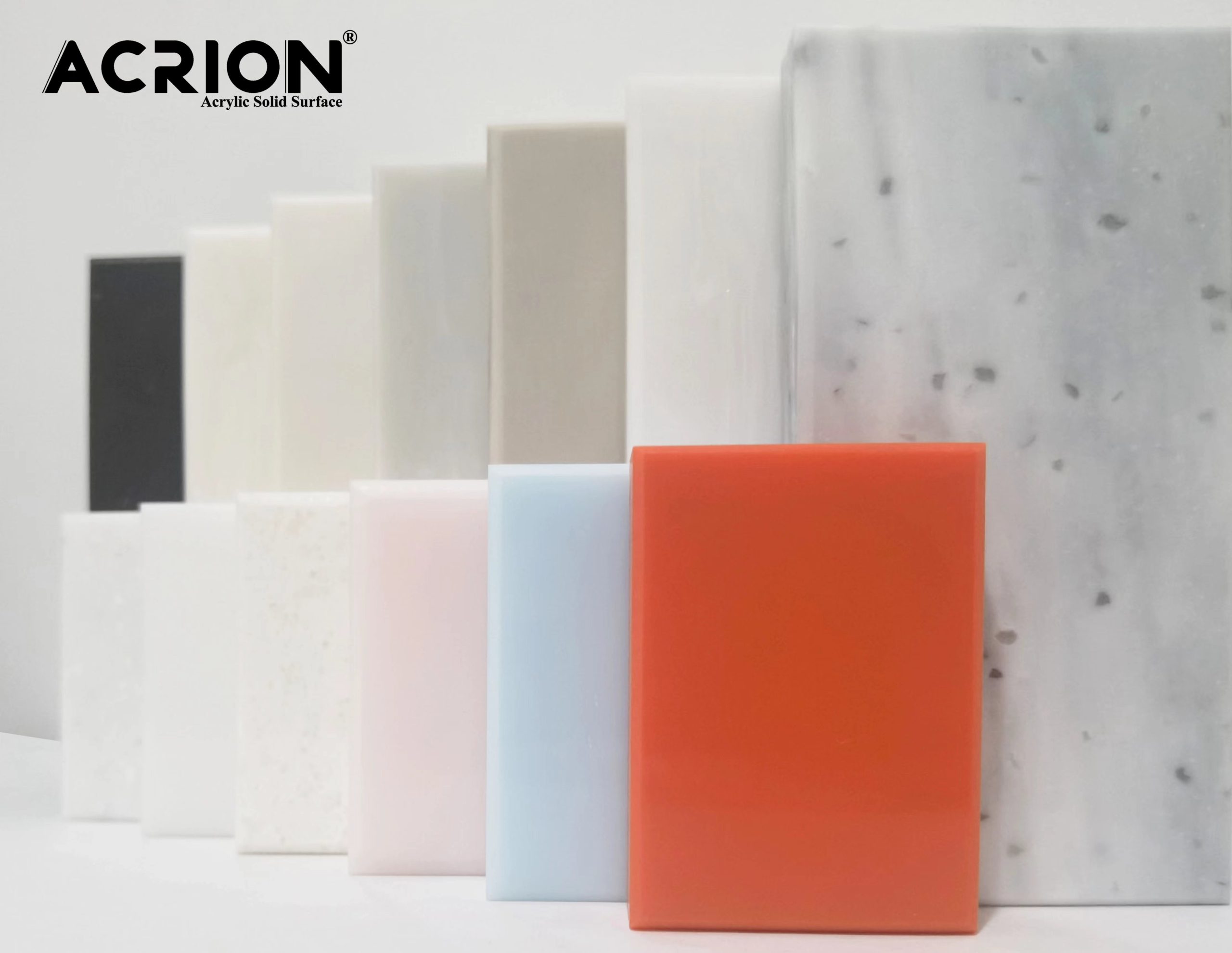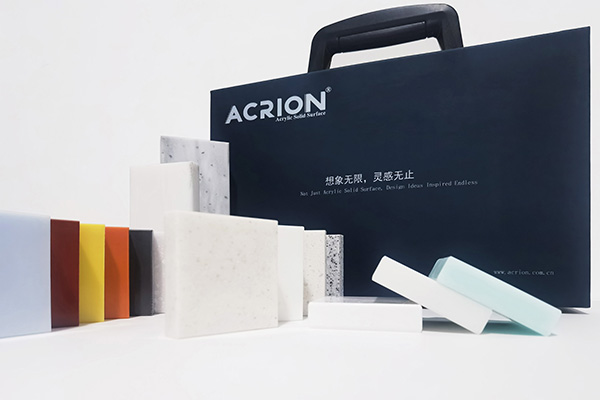L'analyse des performances de résistance à basse température des surfaces solides acryliques doit être effectuée à partir de trois dimensions: la structure des matériaux, la réponse mécanique et l'interaction environnementale, et une évaluation complète doit être effectuée en combinaison avec des tests de laboratoire et des scénarios d'application réels. L'analyse suivante est réalisée à partir de trois aspects: indicateurs de performance clés, méthodes de test et mécanismes de défaillance:
Tout d'abord, les changements dans les propriétés physiques dans des environnements à basse température
L'influence de la température de transition du verre (TG)
Le Tg de la résine acrylique est généralement comprise entre 0 ℃ et 50 ℃. Lorsque la température ambiante est inférieure à TG, le revêtement passe d'un état très élastique à un état vitreux et la capacité de mouvement de la chaîne moléculaire diminue considérablement. Par exemple, un revêtement avec un Tg de 10 ℃ peut avoir sa flexibilité réduite de plus de 50% dans un environnement de -10 ℃, entraînant une baisse de la résistance à l'impact.
Phénomène d'embrimance à basse température
Une fracture fragile peut se produire dans le revêtement dans la plage de -30 ℃ à -50 ℃. Il peut être observé par le test d'impact Notch que le revêtement avec une fracture ductile à température ambiante se transforme en fracture fragile à basse température, et la section transversale montre une caractéristique de type miroir, indiquant que l'énergie de propagation des fissures est considérablement réduite.
Accumulation de stress de contraction
La basse température fait rétrécir le volume du revêtement. Si le coefficient d'extension thermique ne correspond pas à celui du substrat, il peut déclencher une contrainte interfaciale. Par exemple, la différence de taux de rétrécissement entre le revêtement et le substrat métallique peut atteindre 0,5% à -20 ℃, entraînant une diminution de l'adhésion ou de la fissuration du revêtement.
Deuxièmement, la méthode de test pour les performances à basse température
Test de température à basse température
Conformément à la norme GB / T 5470-2008, les échantillons de revêtement ont été placés dans le luminaire refroidi par l'azote liquide et refroidis à une vitesse de 2 ℃ / min. La température à laquelle le revêtement s'est cassé a été enregistré. La température de fragilisation des revêtements acryliques typiques se situe entre -40 ℃ et -60 ℃. En dessous de cette température, le revêtement est sujet aux dommages catastrophiques.
Test de flexion à basse température
Après avoir gardé l'échantillon enduit à -20 ℃, -40 ℃ et -60 ℃ pendant 2 heures, effectuez immédiatement un test de flexion de 180 °. Observez s'il y a des fissures ou des pelage à la surface du revêtement. Par exemple, lorsque le rayon de flexion est inférieur à 5 mm à -40 ℃, le revêtement peut développer des microfissures au niveau de 0,1 mm.
Test d'adhésion à basse température
Après avoir été maintenu à la température réglée pendant 30 minutes, l'adhésion a été évaluée par la méthode de la grille. Par exemple, un revêtement de grade d'adhésion 0 à température ambiante peut chuter à la grade 2 à -30 ℃, ce qui indique que la basse température entraîne un affaiblissement de la force de liaison interfaciale.
Test de cyclisme à basse température
Pour simuler la différence de température entre le jour et la nuit, l'échantillon de revêtement a été soumis à 100 cycles froids et chauds dans la plage de -40 ℃ à 20 ℃, chaque cycle durant 2 heures. Observez si le revêtement montre de la poudre, de bouillons ou des peeling, et évaluez sa résistance aux intempéries à long terme.
Troisièmement, les mécanismes de défaillance dans des environnements à basse température
Craquage causé par le stress interne
Le retrait à basse température provoque une contrainte de traction dans le revêtement. Lorsque la contrainte dépasse la résistance à la traction du revêtement, elle peut déclencher des fissures perpendiculaires à la surface. Par exemple, un revêtement d'une épaisseur de 100 μm peut produire des fissures radiales de 0,2 mm de large à -50 ℃.
Débondissement de l'interface
Si l'adhésion entre le revêtement et le substrat est insuffisante, un retrait à basse température peut provoquer un pelage d'interface. On peut observer par SEM que la coupe transversale du revêtement traité à -30 ℃ montre une séparation intercouche évidente et que le résidu à l'interface est réduit.
La séparation de la microphase s'intensifie
À basse température, la compatibilité entre les segments mous et durs dans la résine acrylique diminue, ce qui peut entraîner une séparation de microphase. Par exemple, les copolymères avec des différences significatifs dans TG peuvent présenter des structures de séparation de phases au niveau de 5-10 μm à -20 ° C, ce qui affecte l'uniformité du revêtement.
Quatrièmement, vérification des scénarios d'application réels
Les murs extérieurs des bâtiments dans des régions extrêmement froides
Dans un environnement de -40 ℃, la résistance du revêtement aux cycles de congélation doit être vérifiée. Par exemple, trempez l'échantillon enduit dans l'eau et congelez-le à -40 ℃, puis transférez-le à 20 ℃ pour la fusion. Répétez cela 50 fois et observez si le revêtement se déroge.
Équipement de transport de la chaîne du froid
Pour les environnements de stockage à froid allant de -25 ℃ à -18 ℃, il est nécessaire de tester la résistance à la corrosion du revêtement dans des conditions à basse température et à haute humidité. Par exemple, une fois le revêtement maintenu à -20 ℃ et 90% RH pendant 72 heures, que le gel blanc ou la rouille apparaisse à la surface.
Revêtement d'équipement polaire
Dans des conditions extrêmement froides de -60 ℃, la résistance à l'impact du revêtement doit être évaluée. Par exemple, un test d'impact sur le marteau de chute a été adopté. Le revêtement a été touché à -60 ℃ avec une énergie de 1J, et il a été enregistré si des fissures visibles se produisaient.
Cinquième, direction d'optimisation des performances
Conception de la structure moléculaire
L'introduction de segments flexibles (comme l'acrylate de butyle) peut réduire le TG et améliorer la ténacité à basse température. Par exemple, la copolymérisation de l'acrylate d'éthyle avec de l'acrylate de butyle peut réduire le TG de 20 ℃ à -10 ℃, améliorant considérablement les performances à basse température.
Réglementation de la densité de réticulation
La réticulation modérée peut améliorer la force du revêtement, mais la réticulation excessive réduira sa flexibilité. Par exemple, en ajustant la dose de l'agent de réticulation, la température de brimiditlément à basse température peut être réduite de 10 ℃ tout en maintenant la dureté.
Modification de la charge
L'ajout de charges à l'échelle nanométrique (comme la silice furieuse) peut inhiber la propagation des fissures. Par exemple, l'ajout de nano-remplateurs de 5% peut augmenter l'allongement à la rupture du revêtement de 20% à -40 ℃.



